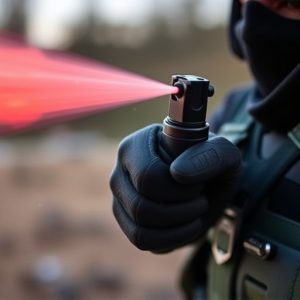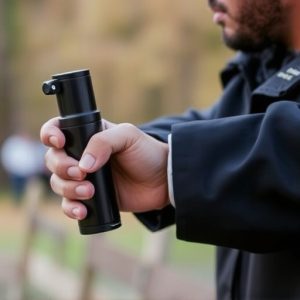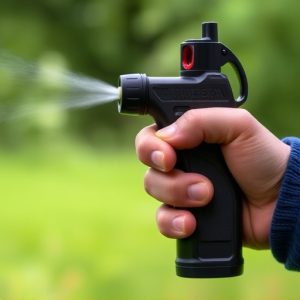Pepper Spray Safety and Use: A Comprehensive Guide for Effective Self-Defense and Legal Compliance
When determining the best pepper spray for personal defense, it's crucial to consider factors …….
When determining the best pepper spray for personal defense, it's crucial to consider factors such as Scoville Heat Units (SHU) for potency, legal restrictions on strength and types of pepper spray by state, the type of spray pattern, delivery mechanism, ease of use, portability, brand reliability, and quality control. The effectiveness of pepper spray ranges from gel to foam to traditional liquid forms, each with distinct advantages; for instance, gel is ideal for indoor use due to minimal wind impact, while foam offers a longer range defense. Legal compliance is non-negotiable, so it's essential to verify state and local laws, including age restrictions and permits needed for carrying pepper spray outside the home. Proper handling and storage ensure the spray retains its effectiveness, and regular maintenance checks are necessary. In terms of usage, a strong OC formula with a range of up to 10 feet is preferable, and it's important to practice with the spray in a secure environment to understand its impact and proper application. Always remember to remove any accessories that could trap the irritant post-activation and seek medical attention if necessary. Integrating pepper spray into a broader self-defense strategy, including situational awareness and vocal alarms for help, is key for effective personal protection. How to buy the right pepper spray involves a careful balance of these attributes to meet both your safety needs and legal requirements.
When it comes to personal safety, understanding the tools at your disposal is crucial. This article delves into the nuances of pepper spray, a non-lethal self-defense mechanism that can effectively deter attackers. We’ll explore various types and their optimal uses, providing guidance on how to buy the right pepper spray for your needs. Moreover, we’ll navigate the complex web of legal requirements across different states, ensuring you remain compliant. Safe handling and storage are paramount in maintaining the efficacy of your pepper spray; we’ll outline best practices. Lastly, a detailed protocol for employing pepper spray in self-defense scenarios will be presented to ensure your safety and that of those around you.
Understanding Pepper Spray Types and Their Uses for Effective Self-Defense
When considering pepper spray for self-defense, it’s crucial to understand the different types available and their intended uses. Pepper spray, also known as OC (Oleoresin Capsicum) spray, is a non-lethal self-defense tool that temporarily causes extreme pain and incapacitates an attacker. It comes in various forms, such as pepper gel, foam, or the traditional spray, each with its advantages and ideal scenarios for use. For instance, pepper gel minimizes wind blowback and can be used indoors, making it a versatile choice for indoor environments. On the other hand, foam is designed for longer range defense, effectively slowing down an assailant at distances up to 12 feet.
Choosing the right pepper spray involves considering factors like your environment, potential attack scenarios, and personal comfort with the product. For effective self-defense, consider key features such as the spray’s concentration of capsaicinoids, which dictates its potency; the amount of pepper spray in each canister, affecting its duration of effect; and the delivery mechanism, which can range from a keychain model for everyday carry to a larger canister with a longer nozzle for greater distance. Additionally, it’s important to buy pepper spray that complies with local laws and regulations, ensuring legal use and carrying. By understanding these aspects and adhering to safety guidelines, you can make an informed decision on the best pepper spray for your personal defense needs. How to buy the right pepper spray involves researching, comparing products, reading reviews, and selecting a model that aligns with both your self-defense requirements and legal constraints in your area.
Factors to Consider When Buying the Right Pepper Spray for Personal Safety
When selecting the appropriate pepper spray for personal safety, it’s crucial to consider several key factors to ensure both effectiveness and legal compliance. Firstly, evaluate the strength of the pepper spray, often measured in Scoville Heat Units (SHU). Higher SHU levels indicate a stronger pepper spray, which can be more effective in deterring attackers. However, local laws may dictate the maximum allowable strength for civilian pepper sprays, so it’s essential to check these regulations before purchasing.
Additionally, consider the spray pattern and delivery system of the pepper spray. A powerful stream or a fogger/cloud type of dispersion can be more effective depending on the situation and your level of comfort with each option. The ease of use is also paramount; look for pepper sprays that have an ergonomic design and a user-friendly safety mechanism to prevent accidental discharges. Ensure the pepper spray comes with a holster or another carrying case for quick access in an emergency. Lastly, always opt for reputable brands known for their product consistency and quality assurance. By carefully considering these factors, you can make an informed decision on how to buy the right pepper spray that aligns with your personal safety needs.
Legal Restrictions and Requirements for Pepper Spray Ownership Across Different States
When considering the purchase and ownership of pepper spray, it’s crucial to be aware of the varying legal restrictions and requirements across different states in the United States. Each state has its own regulations governing the sale, possession, and use of self-defense sprays like pepper spray. Prospective buyers must first determine the legality of purchasing pepper spray in their specific jurisdiction. For instance, some states may restrict the purchase to individuals who have attained a certain age or who can demonstrate a legitimate need for self-defense. Additionally, there may be limitations on the strength or type of pepper spray that can be legally owned. Some states cap the concentration of oleoresin capsicin, while others prohibit certain formulations that can be considered more potent.
To navigate these legal landscapes and comply with state laws, it’s imperative to conduct thorough research before how to buy the right pepper spray. This includes checking both state statutes and local ordinances, as there may be additional restrictions imposed at the city or county level. For example, certain municipalities might require a permit to carry pepper spray outside of one’s home, while in other areas, there may be restrictions on the size or type of container allowed. Always verify that the product you intend to purchase meets all legal criteria for your state and intended use. By doing so, you can ensure compliance with the law and make an informed decision when choosing a pepper spray defense option that’s both effective and legally permissible.
Safe Handling and Storage Practices to Ensure Your Pepper Spray's Integrity
When purchasing pepper spray, it’s crucial to select a product that aligns with your specific self-defense needs. To buy the right pepper spray, consider the strength of the spray, the type of pepper used, and whether you require a model designed for personal protection or one suitable for professional use. Always opt for reputable brands that provide clear instructions on usage and offer products tested and certified to industry standards.
Once you’ve acquired your pepper spray, safe handling and storage practices are paramount to maintain its integrity. Store the canister in a cool, dry place, away from excessive heat or cold, which can affect the chemical composition and pressure within the device. Keep it out of reach of children and pets to prevent accidental discharges or misuse. Regularly inspect your pepper spray for leaks or expiration dates, ensuring it’s ready for use when needed. Proper maintenance includes testing the spray in a safe environment according to the manufacturer’s guidelines, as well as replacing it every one to two years, depending on the product and local regulations. By adhering to these safety measures, you can trust in your pepper spray as a reliable personal defense tool.
Step-by-Step Protocol for Using Pepper Spray in Self-Defense Situations Safely and Effectively
When faced with a self-defense situation, it’s crucial to react swiftly and effectively. One of the most accessible non-lethal defense tools is pepper spray. To use pepper spray safely and effectively, follow these step-by-step protocols. Firstly, ensure you understand the local laws regarding pepper spray possession and usage; this includes how to buy the right pepper spray that complies with legal standards and your specific needs. Typically, an effective self-defense spray should have a range of up to 10 feet, be easy to operate under stress, and contain a potent formula like OC (oleoresin capsicum).
When confronted by an aggressor, maintain a safe distance and aim the pepper spray nozzle towards the eyes or face of the attacker. Direct the spray away from your own face and eyes, as crosswinds can cause the irritant to blow back. Upon activation, quickly move to a safer location while keeping the spray directed away from you. It’s important to practice using your pepper spray in a controlled environment to familiarize yourself with its operation and effects. This will ensure that, in an actual self-defense scenario, you can deploy it effectively without fumbling or wasting the spray. Always remember to remove contact lenses or goggles before using the spray, as these could trap the irritant and worsen the effects. After using the pepper spray, seek medical attention immediately if necessary, and ensure you rinse your eyes and skin thoroughly with a gentle stream of water. Remember, while pepper spray can be an effective deterrent, it is merely one component of a comprehensive self-defense strategy that should include awareness, avoidance, and, if necessary, shouting to attract attention.


